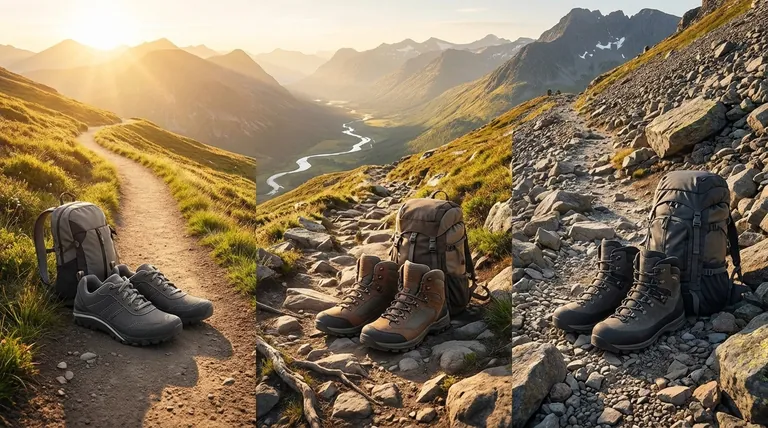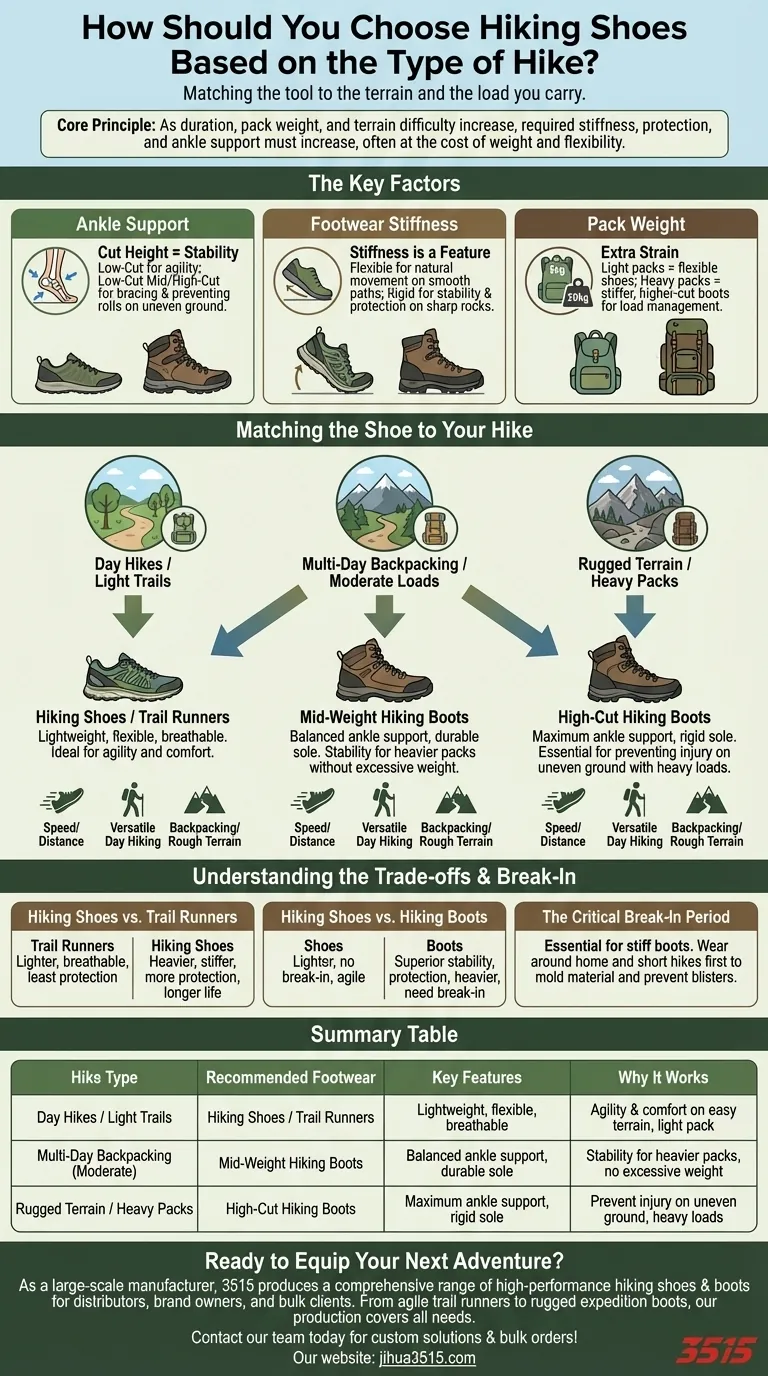Choosing the right hiking shoe is about matching the tool to the terrain and the load you carry. For short, fast hikes on easy trails with a light pack, a flexible, low-cut hiking shoe or even a trail runner is best. As the trail becomes more rugged, the hike gets longer, and your pack gets heavier, you must shift toward a more rigid and supportive high-cut hiking boot to ensure stability and prevent injury.
The core principle is a direct trade-off. As your hike's duration, pack weight, and terrain difficulty increase, the required stiffness, protection, and ankle support of your footwear must also increase, often at the cost of weight and flexibility.

The Key Factors: Terrain, Weight, and Duration
Your footwear choice hinges on three interconnected variables. Understanding how they influence your needs is the key to selecting the right shoe and avoiding discomfort on the trail.
The Role of Ankle Support
The height of your shoe's collar—often called the "cut"—is directly related to stability. A low-cut shoe allows for maximum ankle flexibility, which feels agile and light on smooth trails.
A mid or high-cut boot, which extends above the ankle, acts like a brace. It provides critical support that helps prevent your ankle from rolling on uneven, rocky ground, especially when the fatigue of a long hike sets in or you're carrying the destabilizing weight of a heavy backpack.
Understanding Footwear Stiffness
Stiffness is not a flaw; it's a feature. A highly flexible shoe feels comfortable and allows your foot to move naturally, which is perfect for well-maintained paths.
A rigid shoe, with a stiff midsole and outsole, provides a stable platform. This protects your feet from sharp rocks underfoot and reduces the muscular strain on your feet over long distances, as the boot does more of the work to maintain its shape.
The Impact of Pack Weight
The weight on your back directly translates to the force on your feet and ankles. A light daypack (under 15-20 lbs) puts minimal extra strain on your joints, making lightweight and flexible shoes a viable option.
Once you carry a heavy backpack for a multi-day trip, that weight fundamentally alters your center of gravity. The stability and support of a stiffer, higher-cut boot become essential to manage the load and protect your ankles from injury.
Matching the Shoe to Your Hike
With these principles in mind, we can map specific types of footwear to common hiking scenarios.
For Day Hikes and Light Trails
This is the ideal environment for classic hiking shoes or trail-running shoes. Your pack is light, and the terrain is predictable.
The priority here is comfort, low weight, and breathability. The flexibility of these shoes reduces fatigue and keeps you feeling agile on the path.
For Multi-Day Backpacking with Moderate Loads
This is where the decision becomes more nuanced. A sturdy, low-cut hiking shoe can work for experienced hikers with strong ankles on well-maintained trails.
However, for most people, this is the territory of the mid-weight hiking boot. It offers a balance of ankle support for a heavier pack without the extreme rigidity and weight of a heavy-duty mountaineering boot.
For Rugged Terrain and Heavy Packs
When traversing off-trail, rocky, or mountainous terrain with a heavy expedition pack, a traditional hiking boot is non-negotiable.
Its high cut provides maximum ankle support, and its rigid sole protects your feet from punishing ground. The robust construction is designed for durability and stability when you need it most.
Understanding the Trade-offs
Choosing footwear is never about finding one perfect shoe, but about accepting the right set of compromises for your specific activity.
Hiking Shoes vs. Trail Runners
Trail runners are the lightest and most breathable option, but they offer the least protection and durability. Hiking shoes are slightly heavier and stiffer, providing significantly more underfoot protection and a longer lifespan in exchange for a small weight penalty.
Hiking Shoes vs. Hiking Boots
This is the classic trade-off between agility and support. A hiking shoe is lighter and requires almost no break-in period. A hiking boot provides far superior ankle stability and foot protection at the cost of increased weight, reduced breathability, and the need for a proper break-in period.
The Critical Break-In Period
Never take a brand-new pair of stiff boots on a long-distance hike. Wear them around your home and on several shorter day hikes first. This allows the material to mold to your foot and helps you identify potential hot spots before they become debilitating blisters miles from the trailhead.
Making the Right Choice for Your Goal
- If your primary focus is speed and distance on well-maintained trails: A trail-running shoe offers the best combination of low weight and flexibility for moving fast.
- If your primary focus is versatile day hiking and short backpacking trips: A low-cut hiking shoe provides the ideal balance of comfort, traction, and underfoot protection.
- If your primary focus is backpacking with a heavy pack or hiking on rough, uneven terrain: A mid or high-cut hiking boot is essential for the ankle support and stability required to prevent injury.
Ultimately, the best footwear is the one that allows you to focus on the experience of the hike, not the pain in your feet.
Summary Table:
| Hike Type | Recommended Footwear | Key Features | Why It Works |
|---|---|---|---|
| Day Hikes / Light Trails | Hiking Shoes / Trail Runners | Lightweight, flexible, breathable | Ideal for agility and comfort on easy terrain with a light pack. |
| Multi-Day Backpacking (Moderate Loads) | Mid-Weight Hiking Boots | Balanced ankle support, durable sole | Provides stability for heavier packs without excessive weight. |
| Rugged Terrain / Heavy Packs | High-Cut Hiking Boots | Maximum ankle support, rigid sole | Essential for preventing injury on uneven ground with heavy loads. |
Ready to Equip Your Next Adventure with the Perfect Hiking Footwear?
As a large-scale manufacturer, 3515 produces a comprehensive range of durable, high-performance hiking shoes and boots tailored for distributors, brand owners, and bulk clients. Whether you need agile trail runners for light hikes or rugged boots for heavy-duty backpacking, our production capabilities cover all types of footwear to meet your exact needs.
Let us help you provide the right gear for every trail — Contact our team today to discuss custom solutions, bulk orders, or partnership opportunities!
Visual Guide

Related Products
- Durable Rubber Sole Outdoor Shoes Wholesale & Custom Manufacturing
- Safety Footwear Wholesale Manufacturer for Custom OEM/ODM Production
- Durable Waterproof Rain Boots | Custom Manufacturer for Wholesale & Brands
- Wholesale Safety Footwear Manufacturer for Bulk & Custom OEM Orders
- Wholesale Durable Breathable Safety Boots Custom OEM Manufacturer
People Also Ask
- What were traditional shoe soles made from before rubber? The History of Leather Soles
- Why are rubber-soled shoes considered multi-weather footwear? Unlock All-Season Traction & Protection
- How does cushioning work in hiking shoes? The Science of Shock Absorption
- What are the characteristics of heavy-duty hiking boots? Ultimate Guide for Rugged Terrain
- What are some alternatives to hunting boots? Hiking, Rubber & Tactical Boots Explained



















